In a previous article, I identified a number of left-handed batters that could potentially improve with the ban on defensive shifts. It is one of four new rule changes coming to Major League Baseball in 2023 that could greatly improve the run-scoring rate for offenses.
The flip side, though, is that it likely means that pitchers who utilized the shift to get LHBs out last season could see regression this year in their ERAs. This is especially concerning for pitchers who play on subpar defensive squads. Pitchers on teams with below-average defenses could get away with a bad pitch to a lefty hitter when an extra defender was positioned between first and second base, but that advantage will be removed in 2023, so many pitchers will lose a crutch they depended on to keep their ratios down.
Pitchers also tend to have lower BABIPs (better “luck”) when pitching with a shift than without one. Tyler Mahle pitched into the shift 39.8% of the time in 2022. He had a .193 BABIP with the shift on, and a .345 BABIP without a shift. Many other pitchers possess similar splits and should see ERA regression as their BABIPs, along with those of the batters they face, climb to normal ranges.
To identify pitchers in danger of regressing due to the shift ban, I used Statcast to identify several factors:
- Pitchers with the most balls pulled into the shift against them by LHBs
- Pitchers with the most pulled line drives into the shift against them by LHBs
- Pitchers with the most pulled ground balls into the shift against them by LHBs
Additionally, the information below will show how many outs resulted from each type of ball for each pitcher along with their out percentage, plus which pitchers are more at risk because of the defense behind them.
Here are the pitchers that you may want to think twice about in your fantasy leagues this season.
Which Pitchers Had The Most Balls Pulled Into the Shift By LHBs?
| Player Name | Balls Pulled Into Shift By LHB | Resulted in Outs | Out% |
| Jose Urquidy | 83 | 56 | 67 |
| Logan Webb | 81 | 55 | 68 |
| Sandy Alcantara | 80 | 62 | 78 |
| Yu Darvish | 78 | 61 | 78 |
| Luis Garcia | 75 | 48 | 64 |
| Joe Musgrove | 75 | 49 | 65 |
| Alek Manoah | 74 | 50 | 68 |
| Nick Pivetta | 74 | 50 | 68 |
| Pablo Lopez | 73 | 49 | 67 |
| Johnny Cueto | 71 | 50 | 70 |
| Lance Lynn | 69 | 43 | 62 |
| Tony Gonsolin | 69 | 55 | 80 |
| Adam Wainwright | 65 | 43 | 66 |
| Dylan Cease | 65 | 50 | 77 |
| Corey Kluber | 63 | 41 | 65 |
| Joe Ryan | 63 | 48 | 76 |
| Dylan Bundy | 62 | 49 | 79 |
| Jose Berrios | 60 | 43 | 72 |
| Jakob Junis | 59 | 40 | 68 |
| Christian Javier | 59 | 38 | 64 |
Some of the best pitchers of last season and some highly touted players heading into this season show up on the list above. 2022 National League Cy Young winner Sandy Alcantara had the third most balls pulled into the shift by lefty hitters and benefitted immensely. He saw 78% of those balls turn into outs, the third-highest total behind Dylan Bundy (79%) and Tony Gonsolin (80%)
The cumulative ERA for these pitchers was 3.44, while the MLB average ERA was 3.97. This means, as a group, even though it is a small sample, their cumulative ERA seems to have benefitted from the shift. Also telling is that as a group, they saw 70% of the balls hitters pulled into the shift against them turn into outs. It is reasonable to expect that each of these pitchers sees at least a slight increase in their ERAs in 2023.
Some pitchers of particular concern from the list above are those that have a higher PLA than ERA. PLA is Pitch Level Average and uses IP and the total predicted run value of pitches thrown to provide a value of all pitches using a scale similar to ERA. Those pitchers of concern are Webb, Alcantara, Garcia, Musgrove, Manoah, Cueto, Lynn, Gonsolin, Wainwright, Cease, Ryan, and Javier.
Gonsolin has the largest gap of the pitchers in the list above, with a 4.21 PLA compared to his 2.14 ERA. All four of his pitches were graded as slightly below average according to PLV. This is an issue because pitchers with high-quality pitches can get outs in other ways, and do not necessarily need to rely on their defense or their alignment to get outs. Pitchers whose stuff is not as good are likely to have a harder time getting outs.
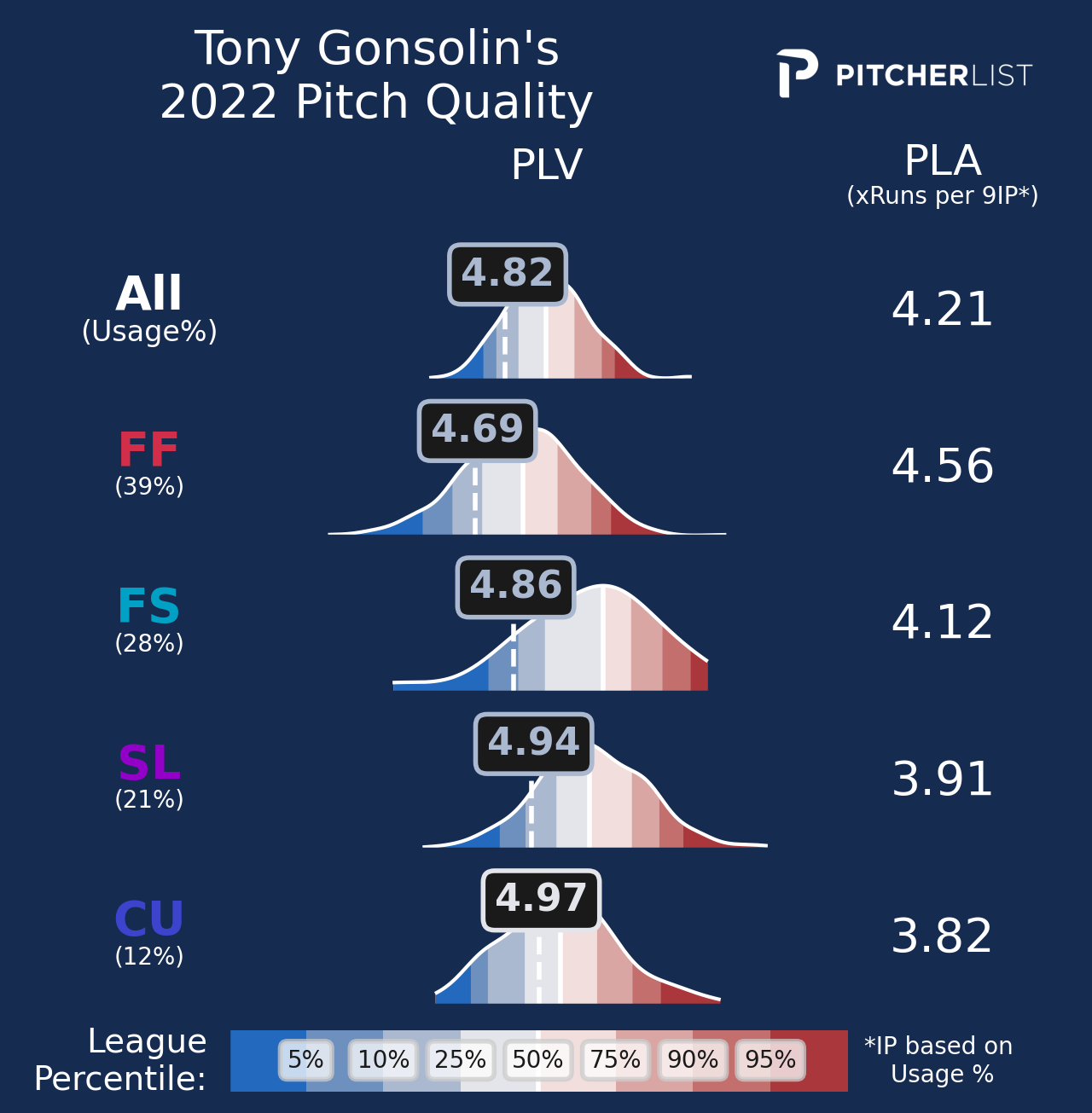
Gonsolin also threw .1% more Bad Pitches than Quality Pitches, something that is unsustainable for a low-2 ERA.
Other concerns include 53% (second most) of pulled line drives into the shift vs LHB and 91% (t-fourth most) of pulled grounders into the shift vs LHB turning into outs. Something like this:
https://gfycat.com/thatbouncyindianabat
Plus, Gonsolin relied on the shift a ton – the Dodgers shifted 70.5% of the time against lefty hitters, which was the third most in baseball. This is a pitcher to be worried about heading into this season.
Manoah had the second-largest gap between his PLA and ERA at 1.65 and is another pitcher who is bound to regress without the shift in 2023.
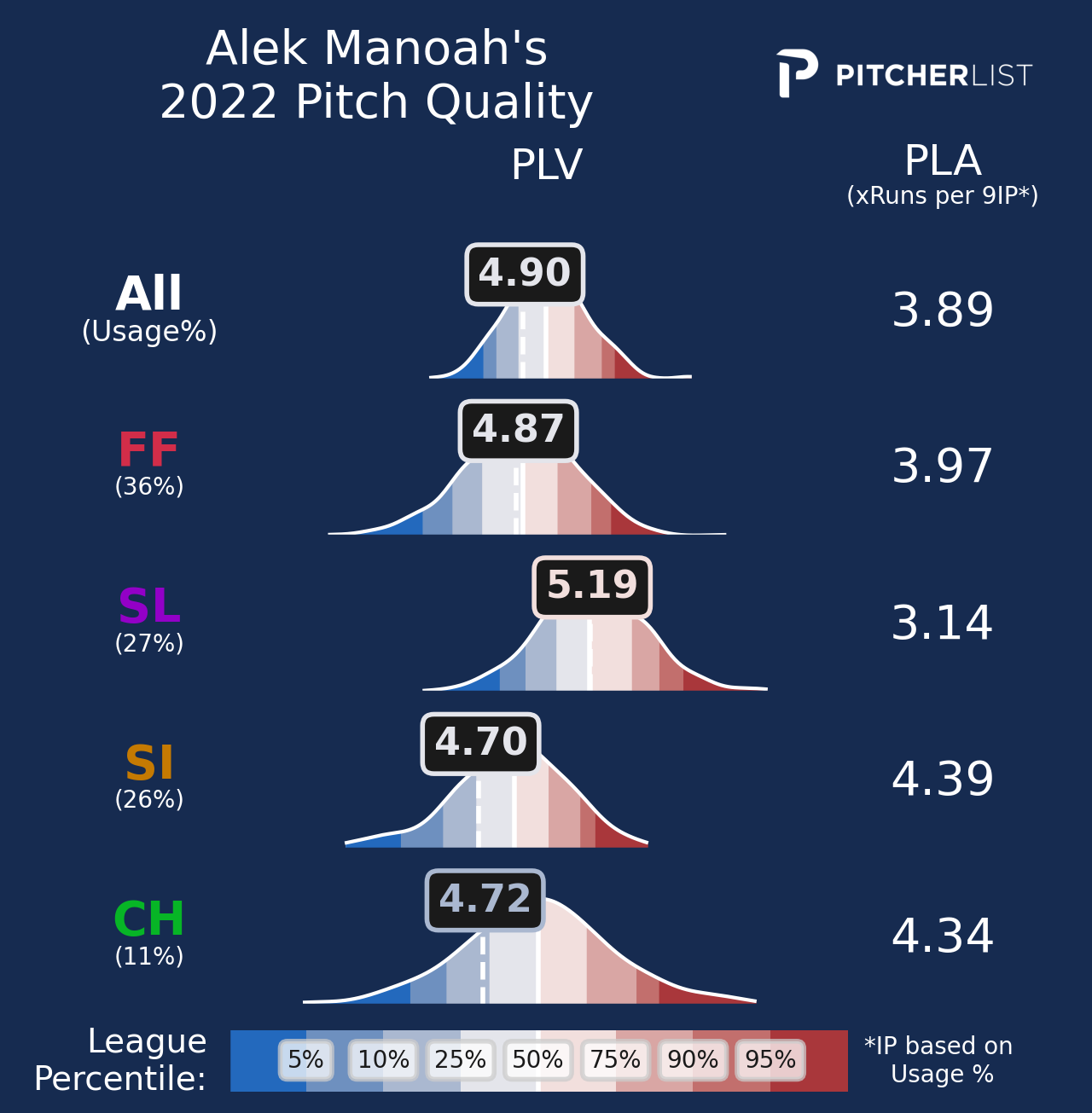
His slider is the only pitch that graded slightly above average. Interestingly, his Quality Pitch, Average Pitch, and Bad Pitch percentages (42%, 21%, and 37% respectively) grade almost identically to pitchers like Merrill Kelly, Andre Pallante, and Matt Wisler.
Manoah also had the ninth-highest percentage of pulled line drives into the shift vs LHB turn into outs at 33%, and the eighth-highest percentage of pulled grounders into the shift vs LHB turn into outs at 86%. Here is a clip of how the shift helped Manoah on a grounder:
https://gfycat.com/clearimmediateflatfish
All of these factors point towards regression for Manoah, and drafters should be wary of where they decide to draft him.
Some other quick concerns:
- Johnny Cueto clearly outperformed his metrics in 2022. He had a negative QP-BP%, and of his five pitches, four graded as below average with his changeup as a borderline Bad Pitch.
- Adam Wainwright’s sinker and fastball both graded as Bad Pitches.
- Lance Lynn had a .06 point difference between his PLA and ERA, but he had three pitches grade below average. His changeup has a 4.14 PLV, which makes it a Bad Pitch. And he plays for the White Sox, whose defense was 28th last season, and now will not have the shift to depend on.
- Nick Pivetta had a better ERA than PLA for 2022, but all four of his pitches were slightly below average, with his changeup grading as a borderline Bad Pitch. Boston’s defense is also subpar – they were 17th last season.
Pitchers from the list above that I am not concerned about in 2023:
- Sandy Alcantara had a .57 difference between his PLA and ERA, but all of his pitches are above average, and Miami had the third-best defense last season and should function similarly in 2023.
- Dylan Cease had a higher PLA than ERA, but his stuff is incredible. His slider had a 5.52 PLV, grading as a quality pitch, and his overall Quality Pitch rate was 49.4% (70th among all 472 pitchers in baseball that have PLV stats).
Which Pitchers Had the Most Line Drives Pulled Into the Shift by LHB?
| Player Name | Balls Pulled Into Shift By LHB | Resulted in Outs | Out% |
| Joe Musgrove | 25 | 12 | 48 |
| Dane Dunning | 23 | 7 | 30 |
| Corey Kluber | 21 | 5 | 24 |
| Alek Manoah | 21 | 7 | 33 |
| Cristian Javier | 21 | 9 | 43 |
| Jose Urquidy | 21 | 9 | 43 |
| Yu Darvish | 20 | 9 | 45 |
| Pablo Lopez | 19 | 5 | 26 |
| Glen Otto | 19 | 9 | 47 |
| Nick Pivetta | 18 | 7 | 39 |
| Adam Wainwright | 18 | 4 | 22 |
| Michael Wacha | 17 | 9 | 53 |
| Merrill Kelly | 16 | 3 | 19 |
| Dylan Bundy | 16 | 9 | 56 |
| Sandy Alcantara | 16 | 6 | 38 |
| Luis Garcia | 16 | 5 | 31 |
| Miles Mikolas | 15 | 5 | 33 |
| Tony Gonsolin | 15 | 8 | 53 |
| Jameson Taillon | 15 | 5 | 33 |
| Aaron Nola | 15 | 7 | 47 |
There are several repeat names on this list from the previous one – something worrying for those pitchers in regard to how much they have been rewarded by the shift.
Pulled line drives are an important point to look into because those are the types of hits that typically have the best outcomes for hitters. So, identifying which pitchers took away the most opportunities for lefty batters to get hits (thanks to the shift) can provide insight into how much these pitchers could regress without the shift.
Dylan Bundy led the way with 56% of pulled line drives into the shift against him by LHB turning into outs. Cristian Javier, whom many expect to take a step forward this season, could actually end up taking a step back thanks to the sixth-highest rate of outs per pulled LD into the shift by LHB. Here is an example of one of them:
https://gfycat.com/electricgloomybaldeagle
Javier appearing for a second time would not be too concerning if not for a few other factors. He has two very good pitches – his slider is a Quality Pitch, and his fastball is slightly above average – but his changeup is a Bad Pitch (4.21 PLV), and his cutter comes in at below league average (4.84 PLV). A .228 BABIP and 9.1% HR/FB rate also suggest regression is on the way, especially with the likelihood of higher BABIPs resulting from more hits due to the shift ban alone. His xFIP last season was 3.53, his SIERA was 3.14, and his PLA was 3.53 – all worse than his 2.54 ERA.
Repeat offenders here include Darvish, Urquidy, Pivetta, Alcantara, Manoah, Garcia, Lopez, and Wainwright. But, as previously mentioned, Alcantara has the stuff and the defense to overcome the shift ban, while the other repeaters may be missing one of those elements that could help them.
Dane Dunning is a pitcher to stay away from in 2023 due in large part to the shift ban. He had the second most pulled line drives and the 11th most outs per pulled LD into the shift by LHB in 2022. Adding to his concerns for this season is that in 2022, his PLA was .26 points higher than his ERA.
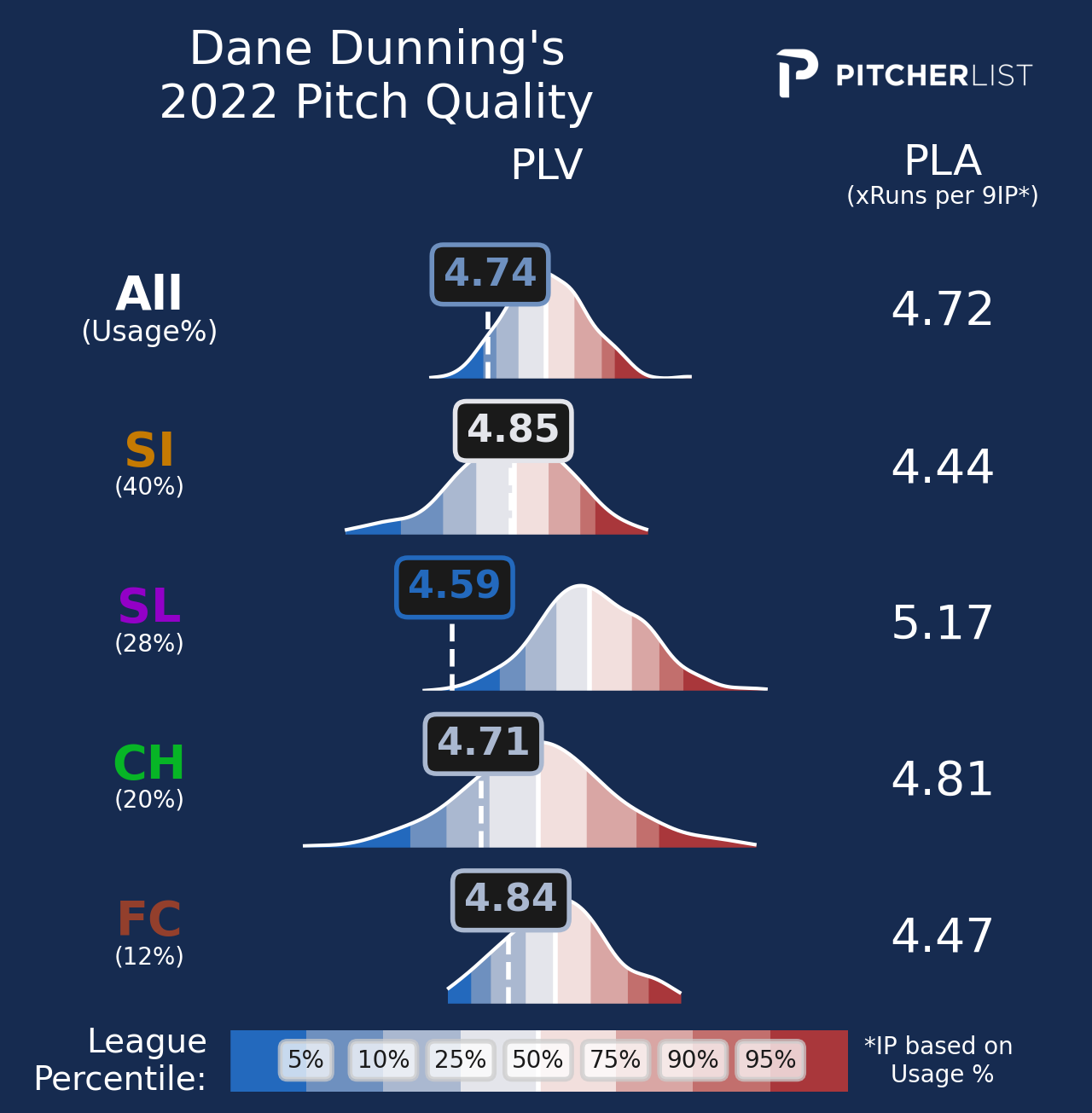
He had the 25th worst QP-BP rate at -2.9%, with all four of his pitches grading as below average. His slider, in particular, was a borderline Bad Pitch by PLV. Texas was the 23rd-ranked defensive team last season, and although they added Corey Seager, he is a below-average defender at shortstop.
Merrill Kelly also possesses some worrying metrics, although only 19% of line drives that lefties hit into the shift against him turned into outs.
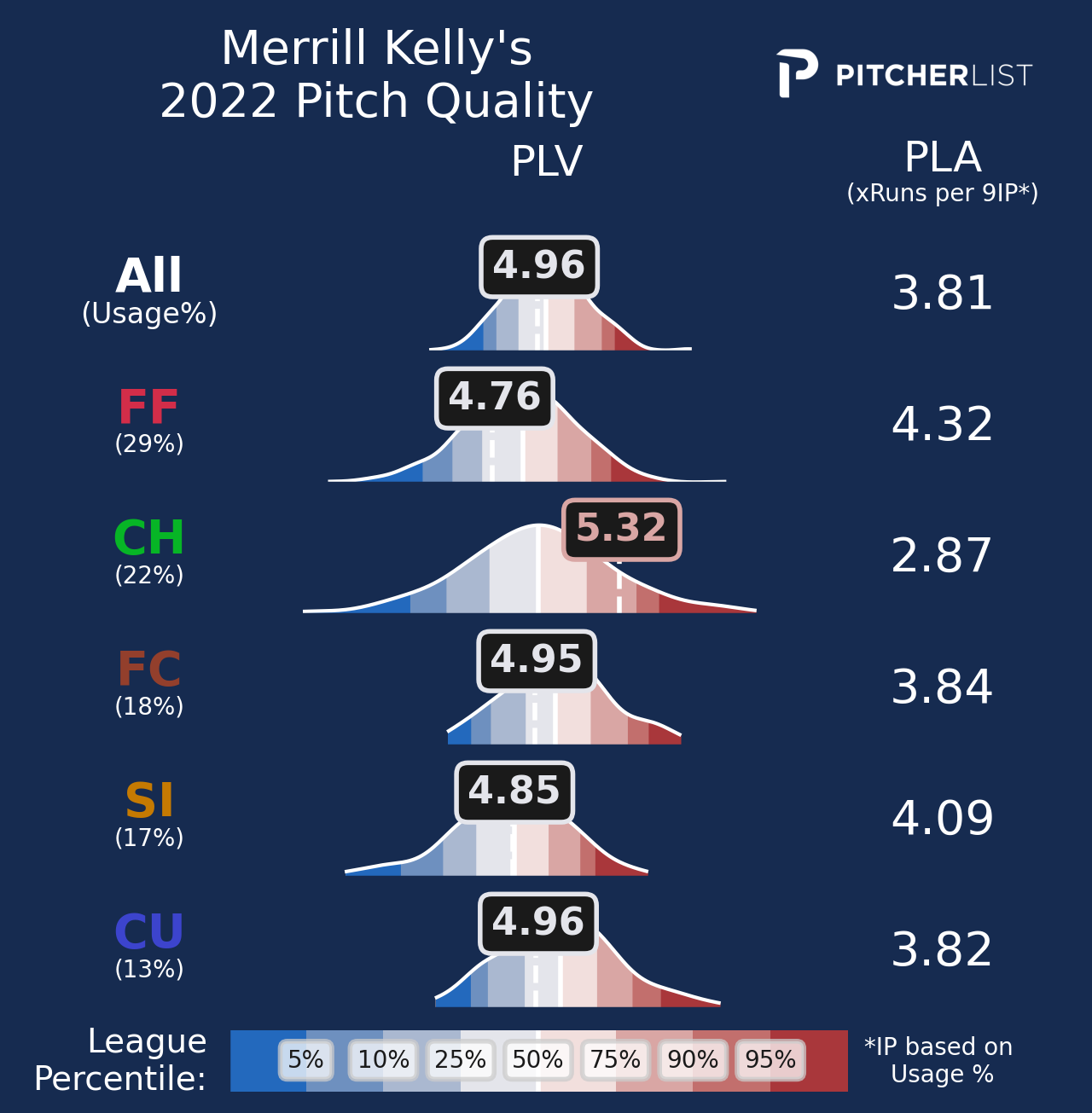
His PLA was .44 points higher than his ERA, and four of his pitches graded slightly below average. Arizona was 18th in fielding last season and lost an above-average defender at CF in Daulton Varsho.
Many of these pitchers should be downgraded in your rankings ahead of the 2023 draft season.
Pitchers from the list above that I am not concerned about in 2023:
- Michael Wacha had a marginally higher PLA compared to his ERA, but only two of his pitches were below average. Despite his sinker being a Bad Pitch, his changeup was a Quality Pitch. He signed with the Padres, who were the eighth-best defensive team in baseball last season.
- Jameson Taillon’s PLA was .21 points lower than his ERA. Three of his pitches were slightly below average, and he signed with the Cubs (24th-ranked defense from 2022, but reshaped their infield with Tucker Barnhart, Dansby Swanson, and Eric Hosmer and added Cody Bellinger to their outfield.
Which Pitchers Had the Most Ground Balls Pulled Into the Shift by LHB?
| Player Name | Balls Pulled Into Shift By LHB | Resulted in Outs | Out% |
| Logan Webb | 60 | 49 | 82 |
| Sandy Alcantara | 49 | 47 | 96 |
| Jose Urquidy | 47 | 39 | 83 |
| Johnny Cueto | 43 | 37 | 86 |
| Tony Gonsolin | 43 | 39 | 91 |
| Pablo Lopez | 41 | 37 | 90 |
| Joe Musgrove | 41 | 33 | 80 |
| Yu Darvish | 40 | 37 | 93 |
| Corbin Burnes | 39 | 36 | 92 |
| Adam Wainwright | 37 | 33 | 89 |
| Alek Manoah | 36 | 31 | 86 |
| Lance Lynn | 36 | 28 | 78 |
| Jakob Junis | 34 | 30 | 88 |
| Luis Garcia | 33 | 28 | 85 |
| Dylan Cease | 33 | 26 | 79 |
| Nick Pivetta | 33 | 30 | 91 |
| Zac Gallen | 32 | 29 | 91 |
| Paolo Espino | 32 | 29 | 90 |
| Shane Bieber | 32 | 26 | 81 |
| Jose Berrios | 31 | 28 | 90 |
Ten pitchers appear here for a third time thanks to their propensity for getting lefty batters to hit into the shift. They are Alcantara, Urquidy, Gonsolin, Lopez, Musgrove, Darvish, Wainwright, Manoah, Garcia, and Pivetta.
Webb, Cueto, Lynn, Junis, Cease, and Berrios appear for a second time.
The out percentage is so much higher on this list because grounders turn into outs more than line drives. This means that these pitchers may be good at inducing ground balls, and they also used the shift to add outs to balls that may have otherwise been hit into a gap.
Logan Webb is a name to downgrade in rankings thanks, for the most part, to the shift ban. He saw the most pulled grounders by LHB get pulled into the shift, with 82% of them resulting in outs like this one here:
https://gfycat.com/braveevenbeardeddragon
He also regressed in K/9, LOB%, and GB% from 2021 to 2022. He allowed more contact last season than in the previous. And his HR/FB rate of 8.3% from last year is better than the league average. All of these factors likely explain the gap between his 2.90 ERA and his 3.59 xERA, 3.31 xFIP, 3.56 SIERA, and 3.31 PLA.
Plus, San Francisco was the 27th-worst defense last season, and although they made some additions that could help on defense, he still will be unable to use the shift in the season ahead. It is possible, but unlikely, that the Giants make huge leaps on defense, putting Webb at risk of regression.
Yu Darvish has excellent surface stats, and digging into his PLA and PLV numbers reveal him to be a very talented pitcher.
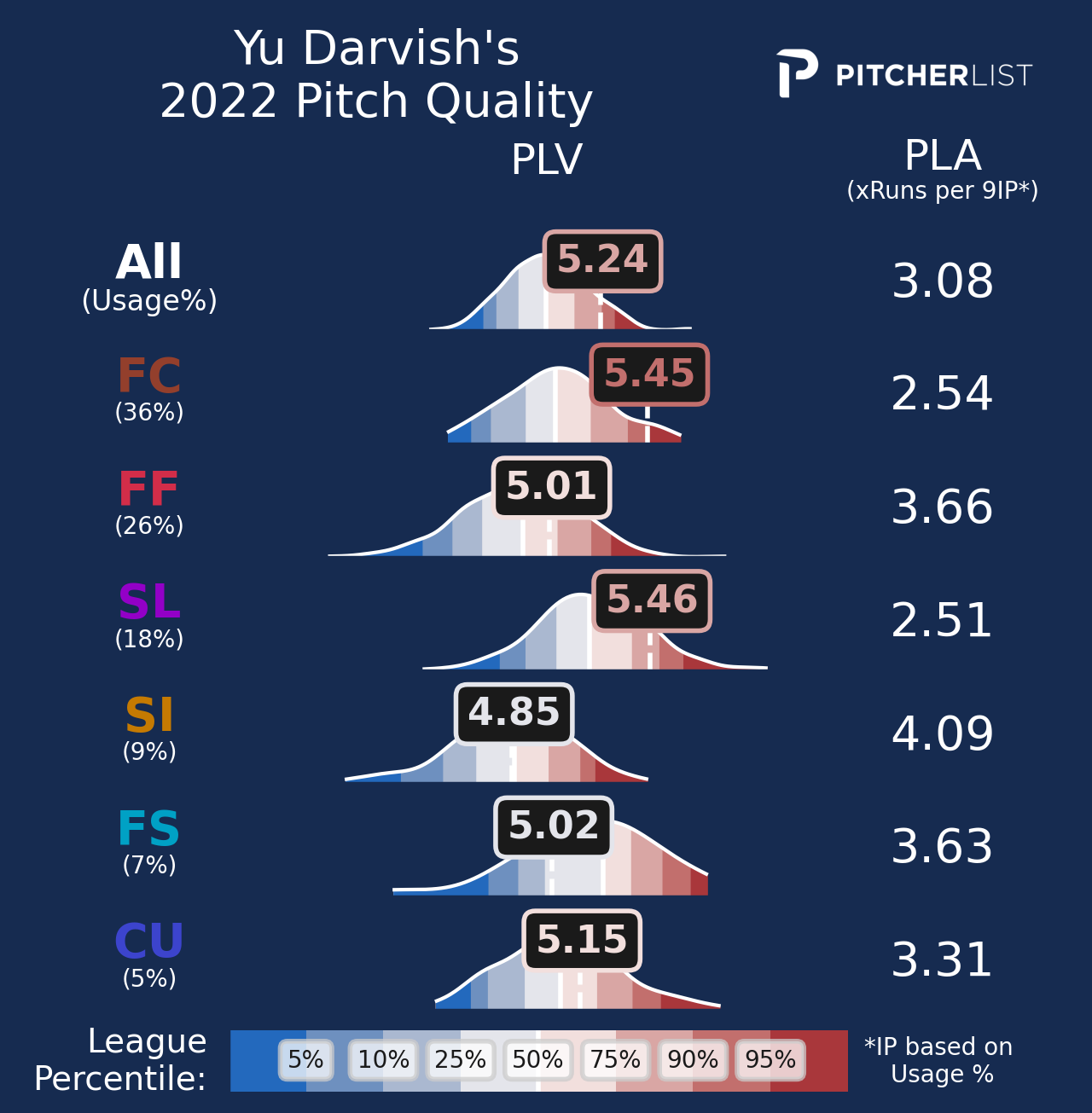
Two of his pitches – his cutter and slider – are .05 PLV points away from being considered Quality Pitches, while only his sinker has a slightly below-league-average grade.
But the fact that he not only was among the most pulled balls, line drives, and groundballs hit into the shift by LHB is problematic. He had the second-highest rate of pulled GB turn into outs against LHB hitting into the shift, the fifth-highest rate for LD, and the third-highest rate for pulled balls overall.
Joe Musgrove tallied the most pulled line drives and the third-highest percentage of outs per pulled LD into the shift by LHB. He was 13th in outs per pulled ground ball to lefty batters but had the seventh most ground balls pulled into the shift against him by LHB. Here is an example of how Musgrove was helped by the shift on a ground ball:
https://gfycat.com/negativewindybellfrog
This ball was out of range of the player covering second base, but because the second baseman had shifted his position into shallow right field, someone was able to get to the ball and force the out. All of the pitchers in the list above have exploited this, some significantly, but will not be able to do so in 2023.
Making matters worse for Musgrove is that three of his pitches were slightly below league average according to PLV (his fastball, curveball, and changeup).
Houston starters Jose Urquidy and Luis Garcia, similar to their counterpart Cristian Javier, have used the shift to manufacture outs. Urquidy’s cutter and curveball came in below league average according to PLV, as did Garcia’s fastball, cutter, and curveball. While Urquidy had a better PLA than ERA, Garcia’s PLA was slightly higher than his ERA. If either pitcher had better pitches, they could likely overcome the shift being taken away.
Yes, Houston values defense – they were the seventh-best defense last season – but used the shift a league-high 82% of the time against LHB. This will not be something their pitchers can lean on in the coming season.
Some other quick concerns:
- Gonsolin, Pivetta, Wainwright, and Lopez clearly punched above their weight last season and are major regression candidates without the shift.
- Jose Berrios, despite his xERA, xFIP, SIERA, and PLA all being better than his ERA, will still likely have a tough time bouncing back to being an above-average pitcher. Toronto shifted 60% of the time against LHB, and Berrios clearly took advantage of it on grounders and overall, yet he still wound up with a 5.23 ERA.
- Shane Bieber is mildly concerning. Four of his pitches were below league average in PLV, and his 2022 PLA was higher than his ERA. However, he has good stuff and overcame the fact that not only was his defense ranked 25th in MLB, but Cleveland was 25th in shift rate vs LHB. He could still do well despite not having the shift at all.
Pitchers from the list above that I am not concerned about in 2023:
- Even though he had the third-highest rate of GB outs per pulled GB into the shift by LHB, and a higher PLA than ERA, Corbin Burnes‘ stuff is immense. This should help him overcome the shift ban. Plus he managed to perform well with the 20th-ranked defense and a defense that shifted the eighth fewest times against lefty batters in the MLB.
- Zac Gallen also should not have a tough time adjusting to life without the shift. He tossed the 23rd fewest bad pitches. His slider graded as a Quality Pitch (5.60 PLV), while his curveball (5.48) and changeup (5.44) were borderline QPs. Also, the Diamondbacks were 20th in shift% vs LHB.
Now what?
Identifying pitchers who are notorious shift-users is essential ahead of the 2023 season because it is those pitchers in particular who need to be downgraded in rankings.
By no means are these lists the “be-all-end-all.” I only included 20 pitchers on each list. A search on Baseball Savant will reveal many more pitchers of the ilk.
There is an endless supply of data available to fantasy managers, and much of it can be interpreted in different ways based on the researcher, but this information is meant to provide guidance on pitchers who are candidates to fade or avoid altogether.
Similar to some lefty batters potentially being better without the shift, pitchers who rely on the shift are not guaranteed to perform worse without it. It is simply likely, based on a number of factors, that some of them will regress in 2023. The pitchers in the tables above are players that you should consider bumping down your rankings for 2023 draft season.


Excellent stuff! Loving these articles
Any plans on an article regarding pitchers or hitters and the pitch clock, or even base stealers and the new rules? (I imagine both of those may be more difficult to quantify for better odds)
Thanks! Not at the moment. I think the data says stealing is basically all but guaranteed to go up. I think the pitch clock issue is going to affect balls and strikes more than scoring plays.